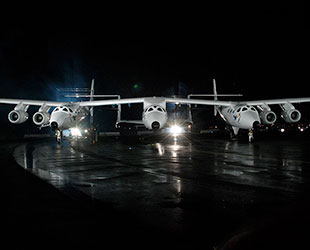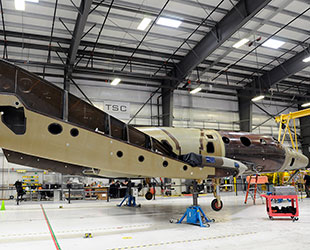Jan. 5, 2016 — Virgin Galactic will roll out and christen its second SpaceShipTwo on Feb. 19, fifteen months after its first suborbital spacecraft was lost during a test flight.
The space tourism company, together with The Spaceship Company, Virgin's manufacturing subsidiary, will reveal the newly-completed vehicle at its Final Assembly, Integration and Test Flight Hangar (FAITH) located at the Mojave Air and Space Port in California. Stephen Hawking, the famed theoretical physicist and cosmologist, is expected to attend the invite-only event to help reveal the craft and the name chosen for the new SpaceShipTwo (SS2).
"We are very honored that Stephen has agreed to help us unveil our new spaceship in February, if he is feeling well enough," said Richard Branson, Virgin Galactic's billionaire founder, in a blog published on his Virgin Group's website last month. Branson also noted he had gifted Hawking with a ticket to fly on SpaceShipTwo — the company's only free ride to date — if his health permits.
(Hawking, who is almost fully paralyzed as the result of the motor neurone disease ALS, experienced floating in zero-g aboard a parabolic training flight in 2007 with no ill effects.)
"Professor Hawking has often spoken of his admiration for what Virgin Galactic is doing to democratize space," wrote Branson, "previously sharing his 'respect for enabling more of humanity to experience the true wonder of space.'"

Virgin Galactic's first SpaceShipTwo, the VSS Enterprise, mounted under WhiteKnightTwo, was revealed in 2009. (collectSPACE) |
On Oct. 31, 2014, Virgin Galactic's original SpaceShipTwo, christened the VSS ("Virgin SpaceShip") Enterprise, broke apart over the Mojave Desert during a powered test flight. The accident claimed the life of co-pilot Mike Alsbury and seriously injured pilot Pete Siebold. Both were working for Scaled Composites, which built the VSS Enterprise.
An investigation led by the National Transportation Safety Board found that the probable cause was "Scaled's failure to consider and protect against the possibility that a single human error could result in a catastrophic hazard to the SpaceShipTwo vehicle."
The VSS Enterprise broke apart after Alsbury prematurely unlocked the ship's innovative feathering system, resulting in its twin tail booms deploying when the aerodynamic and inertial loads on the vehicle were too strong for the craft to handle. The NTSB investigators were unable to determine exactly why Alsbury moved a lever to unlock the feather 14 seconds earlier than was safe to do so.
Branson said the investigation's findings had strengthened Virgin Galactic's resolve to achieve its goals.
"Virgin Galactic is not just about taking people up to space, but also about connecting space to Earth," Branson said in February 2015. "We believe that exploring space will make life better on Earth — a broader perspective is crucial to solving our planet's greatest challenges."

Virgin Galactic's second SpaceShipTwo under construction at the Mojave Air and Space Port, California, in May 2015. (Virgin Galactic) |
The second SpaceShipTwo, which informally was referred to as the VSS Voyager prior to the accident, was about 65 percent complete when the Enterprise was lost. It was first lowered onto its landing gear six months after the tragedy.
As part of completing the ship, safeguards were added to prevent the premature deploy of the tail booms.
The Feb. 19 rollout precedes the restart of Virgin Galactic's SpaceShipTwo test flight program, including captive carry, free flight and powered (engine) flights with the company's WhiteKnightTwo carrier aircraft, VMS ("Virgin MotherShip") Eve.
Virgin Galactic's flight team of seven pilots includes former NASA astronaut Rick "CJ" Sturckow and Kelly Latimer, the first female research test pilot hired by the space agency's Armstrong Flight Research Center in California. The team is led by chief David Mackay, a former Royal Air Force test pilot and Virgin Atlantic captain.
